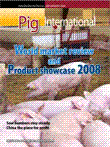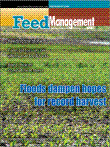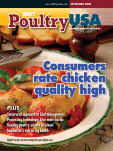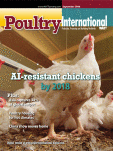Wednesday, June 9, 2010
Saturday, September 19, 2009
Sunday, August 23, 2009
Monday, June 22, 2009
Key Biscayne Compromise: Relief for high grain prices?
Is a proposed compromise on ethanol mandates a win for both poultry and grain producers?
The shouting match between corn producers and livestock producers over U.S. biofuels policy was lowered a decibel or two June 19 when a poultry industry economist and the CEO of the National Corn Growers Association discussed a compromise proposal for a limit on corn use for ethanol and a switch to a variable federal subsidy on ethanol.
With one-third of the nation’s corn crop now going to ethanol production and the government mandated portion still headed upward, poultry and livestock producers are concerned about future corn prices.
During the USA Poultry & Egg Export Council (USAPEEC) Executive Conference & Annual meeting in Key Biscayne, Fla., poultry industry consultant Dr. Paul Aho offered what is being referred to as the Key Biscayne Compromise:
Limit corn use for ethanol to 15 billion gallons
No corn diversion to meet mandates for cellulosic ethanol
Variable blend credit and tariff
15% ethanol-gasoline blends
National Corn Growers Association CEO Rick Tolman, who joined Dr. Aho on the podium as a speaker, called some of the ideas in the proposal “interesting” before a crowd of U.S poultry exporters.
“I like the [proposal for a] variable subsidy,” Tolman said.
In making his proposal, Aho said, “The Key Biscayne Compromise would be to limit the mandated corn use to 15 billion gallons as is laid out in the law today. We’re up to 12 billion gallons next year so 15 billion gallons is not that much further. But let’s limit the mandated use to 15 billion gallons just like the law says, but not use corn if the cellulosic ethanol doesn’t pan out.”
Aho said the variable blend credit in tariff should follow proposals previously made by Dr. Wallace Tyner at Purdue University.
His proposal point on cellulosic ethanol arises from poultry and livestock producers’ concern that additional corn might be diverted to satisfy mandates for the production of ethanol from cellulosic stock. Sixteen billion gallons of ethanol from cellulosic stock are mandated by 2022, but no commercially feasible technology exists to meet the mandate.
Aho also proposed that 15 percent ethanol blends be allowed. “There’s no problem with 15 percent blends if the total mandated use is limited to 15 billion gallons and a variable blend credit is used,” he said.
During a speech that preceded Aho’s compromise proposal, Tolman said corn growers are increasingly productive with U.S. 2007 corn yields at 151.1 bushels per acre. As a result, corn growers are concerned about having markets in place for that production.
Aho responded to the concern by saying that containing high corn prices and reducing price volatility would result in more corn usage in poultry and livestock feeds.
“The important thing is that if we can keep that mandated corn-based ethanol use to 15 billion gallons there may be chance for a compromise here between the users and the producers of corn,” he said.
Speaking before the crowd of exporters, Tolman said the proposal was “interesting,” if the poultry and livestock industries would end up using more corn for chickens, hogs and cattle.
Dr. Aho invited Mr. Tolman to shake hands as a sign of willingness to consider the idea of compromise between users and producers of grain. The two shook hands on stage, though Tolman told the crowd that he does not represent the ethanol industry and cannot represent the corn industry on matters of policy unilaterally.
Following publication of the photo of the handshake, Tolman made it clear through a National Corn Producers Association spokesperson that the handshake “was made out of a desire to work together, not to seal any sort of contract or agreement.”
Mr. Tolman, the spokesperson said, expressed interest at the meeting in further study regarding one or more separate parts of a proposed compromise, such as a variable VEETC (volumetric ethanol excise tax credit).
He emphasized that no compromise agreement was made by Mr. Tolman regarding the future of corn ethanol. Updated June 23: Includes additional clarifying paragraphs. Shown in photo: Dr. Paul Aho, Poultry Perspective, and Rick Tolman, CEO of the National Corn Growers Association.
Thursday, June 18, 2009
Mexico's meat industry shares lessons from 'swine flu'
Mexico’s economy and public infrastructure are still reeling from the outbreak of H1N1 influenza, and meat and poultry industry representatives from Mexico say there are lessons to be learned about the fragility of the world’s health system and the need for better preparation on the part of governments and businesses – especially the meat and poultry industries.
Pork consumption fell 80% and prices fell 25% from April to May following the H1N1 outbreak. In the same period, the average price of pork in Mexican pesos fell from $20.53 per kilo to $16.35 per kilo.
Now the country is dealing with its worst economic crisis in years – on par with the tequila crisis of 1995, an economic downturn of historic proportion for Mexico. Speaking at the USA Poultry & Egg Export Council Executive Conference & Annual Membership Meeting, Eugenio Salinas, the chairman of Consejo Mexicano de la Carne, a leading meat industry group in Mexico, outlined industry responses that helped shore up consumer confidence.
COMECARNE, for example, was instrumental in getting the name of the flu in the outbreak changed from swine flu to human flu. The group also engaged in consumer education, telling consumers pork consumption was safe and not related to catching the flu.
In the wake of the outbreak, the group also pushed five major initiatives: a campaign to restore pork consumption; government procurements; lines of credit; money to support grain purchases; and import substitution by the processing industry.
Salinas, and Cesar de Anda, former UNA president and chairman of the NAFTA Egg and Poultry Partnership, expressed great concern over continued pronouncements by the country’s minister of health that stoke public fear of the potential for an avian flu outbreak.
“The minister has repeatedly reassured consumers over H1N1 by saying ‘at least it’s not the bird flu which would be worse,'” de Anda said.
Mexico’s pork industry, fortunately, did not lose its major export market, Japan. Sales there fell, however, by 15%, said Salinas.
“The experience with H1N1 influenza shows how fragile the world health system is and how easily a new virus can circulate around the world,” he said.
“Last month pork was adversely affected; next time it could be beef or pork or poultry. We have to be prepared to act immediately. Let’s keep working together on a strategic crisis plan for a future outbreak.”
US, Russians to meet about poultry plant delistings
Meeting at the USA Poultry & Egg Export Council Executive Conference & Annual Membership Meeting, the groups are expected to discuss a proposed 90-day investigative period that would take effect before plants are delisted by the Russian government.
The 90-day period, proposed last month at meetings in Paris between Russian and U.S. industry and government representatives, would allow U.S. poultry exporters to appeal delistings before they take effect. Depending on what is worked out, the 90-day period might also permit corrections to processes or facilities in U.S. plants to avoid delistings.
During the first five months of 2009, Russian poultry imports have been down 57%. While the Russian government is working to replace imports with domestic production, the Russian poultry industry is not able to fully supply the demand. As a result, poultry prices to Russian consumers have risen in 2009.
Wednesday, June 17, 2009
Poultry exporters try a change of latitude
Poultry exporters and friends at a reception at the USA Poultry & Egg Export Council’s Executive Conference & Annual Membership Meeting enjoyed the pleasant ocean breezes of Key Biscayne, Fla., Wednesday evening. Thursday, attendees will tackle market development issues as staff members from around the world make presentations.
Subscribe to:
Posts (Atom)











